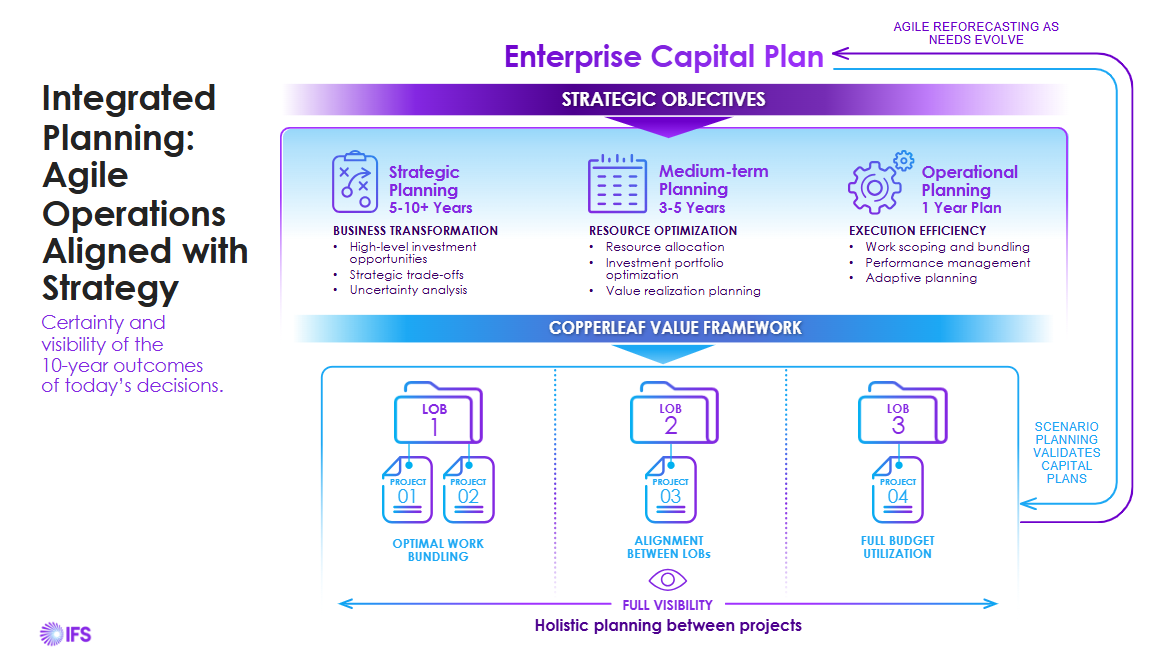Integrated Planning: Bridging the Gap Between Strategy and Execution
Executives face the challenge of ensuring their organization’s strategic vision is effectively translated into execution across all lines of business. However, many organizations lack a clear line of sight from planning to execution, and many end up actioning work that doesn’t serve their strategy at all. Silos exist between lines of business, making it difficult to know if your plans for one will help or hinder strategy in another. Organizations spend long planning cycles on inflexible capital plans without a defensible sense of whether those plans are the right ones. How can executives be sure their strategy is realized across all time horizons and lines of business?
Integrated planning is the holistic approach that bridges this gap.
What is Integrated Planning?
Integrated planning is a comprehensive, enterprise-wide approach that aligns long-term strategic goals with medium-term planning and short-term execution. It requires a cohesive framework that integrates long-term strategic plans, medium-term plans, and annual operating budgets.
Integrated planning breaks down silos across departments and lines of business, enabling organizations to make coordinated, value-based decisions that support corporate strategy. This approach ensures capital planning is both agile and strategically sound—delivering the right work, at the right time, for the right reasons.

Value-Based Integrated Planning with IFS Copperleaf
Without integrated planning, organizations struggle to prioritize investments effectively, often relying on outdated or disconnected planning models. IFS Copperleaf solves this problem with a unified value framework that ensures every investment decision aligns with corporate strategy while honoring real-world constraints. This approach provides a defensible, transparent path from strategic intent to operational execution.
After developing the value framework to codify corporate strategy, IFS Copperleaf clients can use scenario analysis to test their plans. This analysis allows organizations to explore the potential impact of various scenarios, such as regulatory changes or budget adjustments, and understand their effects on asset performance and costs. This proactive approach helps organizations move from reactionary to proactive planning. When plans need to change, IFS Copperleaf can very quickly reforecast plans when needed. This continuous planning capability allows for capital plans to be efficiently re-optimized, ensuring agility and responsiveness in planning processes.
By adopting integrated planning with IFS Copperleaf, executives can ensure organizational strategy is executed effectively through chosen investments, driving long-term success and sustainability.
Key Benefits of Integrated Planning with IFS Copperleaf
- Align operational and strategic goals: Ensure day-to-day operations and short-term plans are in sync with long-term strategic vision of the organization.
- Optimize capital allocation: Make informed decisions on capital allocation across different lines of business, balancing immediate needs with future objectives.
- Enhance strategic execution: Provide a clear roadmap for executing company strategy through well-defined investment plans.
- Improve transparency and accountability: Foster a culture of transparency and accountability by clearly linking investments to strategic goals.
- Drive organizational cohesion: Promote collaboration and cohesion across various departments, ensuring all parts of the organization are working towards common objectives.
- Improve decision speed and confidence: Make high-stakes decisions faster with transparency and data-driven insight.
-
Enable agile planning: Reforecast and reoptimize plans quickly in response to new information or shifting priorities.
Ready to see how integrated planning can transform your organization’s capital planning process? Discover how IFS Copperleaf can help you align strategy with action every step of the way.

